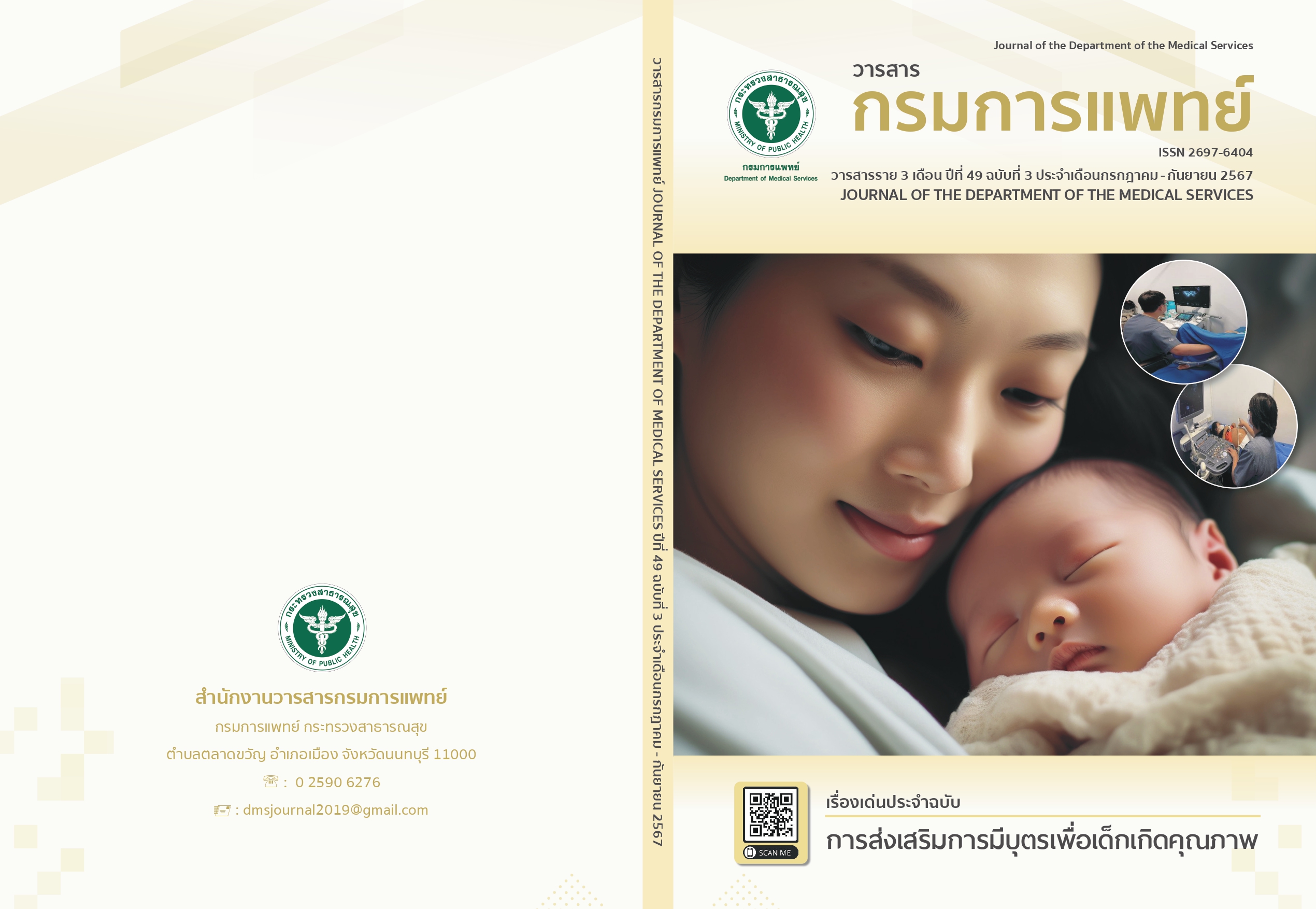Antifungal Susceptibility of Dermatophytes and Non-dermatophytes to Amphotericin B, Terbinafine HCL, Griseofulvin, Ketoconazole and Itraconazol at Institute of Dermatology
Keywords:
Dermatophytes, Non-dermatophyte, AntifungalAbstract
Background: Superficial Fungal infections are showing an escalating resistance to existing antifungal drugs. Effectively choosing an antifungal treatment for a persistent infection relies on identifying the infectious organism(s) and conducting susceptibility testing of the organism(s) to antifungal medications. Objective: The study was aimed at evaluating the susceptibility of dermatophytes and non-Dermatophytes, isolated from patients at the Institute of Dermatology in Thailand, to antifungal agents including amphotericin B (AMP B), terbinafine HCL (TER), griseofulvin (GF), ketoconazole (KCZ), and itraconazole (ITR). Method: The research was conducted following the protocols of Clinical and Laboratory Standards Institute (CLSI), USA. A total of 50 isolates were examined using ITS-PCR sequencing to identify fungal species, including 17 from tinea corporis/cruris, 6 from tinea pedis, and 27 from onychomycosis. Result: The minimal inhibitory concentration (MIC) of AMP B, TER, GF, KCZ, and ITR against dermatophytes ranged from 0.25-4, 0.015-16, 0.06-8, 0.03-8, and 0.007-4 µg/ml, respectively. The minimal fungicidal concentration (MFC) ranges of AMP B, TER, GF, KCZ, and ITR were 0.5-4, 0.015->16, 0.06-16, 0.03->16, and 0.015-8 µg/ml, respectively. For non-dermatophytes, the MIC of AMP B, TER, GF, KCZ, and ITR ranges were 0.003->16, 0.03->16, 16->64, 0.125->16, and 0.25->16 µg/ml, while the MFC ranged from 0.03->16, 0.03->16, 16->64, 0.125->16, and 0.25->16 µg/ml, respectively. Conclusion: The findings suggest that non-dermatophytes, particularly Neoscytalidium dimidiatum, necessitate higher antifungal concentrations than dermatophytes. Terbinafine HCL may be a suitable choice for treating tinea infections caused by both dermatophytes and non-dermatophytes. The correlation between MIC and clinical outcome still needs to be determined for optimal laboratory results interpretation.
References
Ely JW, Rosenfeld S, Seabury Stone M. Diagnosis and management of tinea infections. Am Fam Physician 2014;90(10):702-10.
Sigurgeirsson B, Olafsson JH, Steinsson JB, Paul C, Billstein S, Evans EG. Long-term effectiveness of treatment with terbinafine vs itraconazole in onychomycosis: a 5-year blinded prospective follow-up study. Arch Dermatol 2002;138(3):353-7.
Volk B, Tiu A, St Anna L. Clinical Inquiry: which oral antifungal works best for toenail onychomycosis? J Fam Pract. 2013;62(2):100-1.
Crawford F, Young P, Godfrey C, Bell-Syer SE, Hart R, Brunt E, et al. Oral treatments for toenail onychomycosis: a systematic review. Arch Dermatol 2002;138(6):811-6.
Epstein E. How often does oral treatment of toenail onychomycosis produce a disease-free nail? An analysis of published data. Arch Dermatol 1998;134(12):1551-4.
Evans EG, Sigurgeirsson B. Double blind, randomised study of continuous terbinafine compared with intermittent itraconazole in treatment of toenail onychomycosis. The LION Study Group. Bmj 1999;318(7190):1031-5.
Gupta AK, Cooper EA, Lynde CW. The efficacy and safety of terbinafine in children. Dermatol Clin 2003;21(3):511-20.
Gupta AK, Cooper EA, Paquet M. Recurrences of dermatophyte toenail onychomycosis during long-term follow-up after successful treatments with mono- and combined therapy of terbinafine and itraconazole. J Cutan Med Surg 2013;17(3):201-6.
Gupta AK, Venkataraman M. Antifungal resistance in superficial mycoses. J Dermatolog Treat 2022;33(4):1888-95.
Gupta AK, Renaud HJ, Quinlan EM, Shear NH, Piguet V. The growing problem of antifungal resistance in onychomycosis and other superficial mycoses. Am J Clin Dermatol 2021;22(2):149-57.
Badali H, Mohammadi R, Mashedi O, de Hoog GS, Meis JF. In vitro susceptibility patterns of clinically important Trichophyton and Epidermophyton species against nine antifungal drugs. Mycoses 2015;58(5):303-7.
Dogra S, Shaw D, Rudramurthy SM. Antifungal drug susceptibility testing of dermatophytes: laboratory findings to clinical implications. Indian Dermatol Online J 2019;10(3):225-33.
Rezaei-Matehkolaei A, Khodavaisy S, Alshahni MM, Tamura T, Satoh K, Abastabar M, et al. In vitro antifungal activity of novel triazole efinaconazole and five comparators against dermatophyte Isolates. Antimicrob Agents Chemother 2018;62(5):e02423-17.
CLSI. Reference Method for Broth Dilution Antifungal Susceptibility Testing of Filamentous Fungi. 3rd ed. Pennsylvania (PA): CLSI; 2017.
White TJ, Bruns T, Lee S, Taylor J. 38 - AMPLIFICATION AND DIRECT SEQUENCING OF FUNGAL RIBOSOMAL RNA GENES FOR PHYLOGENETICS. In: Innis MA, Gelfand DH, Sninsky JJ, White TJ, editors. PCR Protocols. San Diego: Academic Press; 1990. p. 315-22.
Jang JH, Lee JH, Ki CS, Lee NY. Identification of clinical mold isolates by sequence analysis of the internal transcribed spacer region, ribosomal large-subunit D1/D2, and β-tubulin. Ann Lab Med 2012;32(2):126-32.
CLSI. Performance Standards for Antifungal Susceptibility Testing of Filamentous Fungi. 1st ed. CLSI supplement M61. Pennsylvania (PA): CLSI; 2017.
Yenişehirli G, Tunçoğlu E, Yenişehirli A, Bulut Y. In vitro activities of antifungal drugs against dermatophytes isolated in Tokat, Turkey. Int J Dermatol 2013;52(12):1557-60.
Singh A, Singh P, Meis JF, Chowdhary A. In vitro activity of the novel antifungal olorofim against dermatophytes and opportunistic moulds including Penicillium and Talaromyces species. J Antimicrob Chemother. 2021;76(5):1229-33.
Espinel-Ingroff A, Cuenca-Estrella M, Fothergill A, Fuller J, Ghannoum M, Johnson E, et al. Wild-type MIC distributions and epidemiological cutoff values for amphotericin B and Aspergillus spp. for the CLSI broth microdilution method (M38-A2 document). Antimicrob Agents Chemother 2011;55(11):5150-4.
Yu L, Zhang W, Wang L, Yang J, Liu T, Peng J, et al. Transcriptional profiles of the response to ketoconazole and amphotericin B in Trichophyton rubrum. Antimicrob Agents Chemother 2007;51(1):144-53.
Mukherjee PK, Leidich SD, Isham N, Leitner I, Ryder NS, Ghannoum MA. Clinical Trichophyton rubrum strain exhibiting primary resistance to terbinafine. Antimicrob Agents Chemother 2003;47(1):82-6.
Santos HL, Lang EAS, Segato F, Rossi A, Martinez-Rossi NM. Terbinafine resistance conferred by multiple copies of the salicylate 1-monooxygenase gene in Trichophyton rubrum. Med Mycol 2018;56(3):378-81.
Machouart M, Menir P, Helenon R, Quist D, Desbois N. Scytalidium and scytalidiosis: what's new in 2012? J Mycol Med 2013;23(1):40-6.
Martins MP, Franceschini ACC, Jacob TR, Rossi A, Martinez-Rossi NM. Compensatory expression of multidrug-resistance genes encoding ABC transporters in dermatophytes. J Med Microbiol 2016;65(7):605-10.
Downloads
Published
How to Cite
Issue
Section
License
Copyright (c) 2024 Department of Medical Services, Ministry of Public Health

This work is licensed under a Creative Commons Attribution-NonCommercial-NoDerivatives 4.0 International License.
บทความที่ได้รับการตีพิมพ์เป็นลิขสิทธิ์ของกรมการแพทย์ กระทรวงสาธารณสุข
ข้อความและข้อคิดเห็นต่างๆ เป็นของผู้เขียนบทความ ไม่ใช่ความเห็นของกองบรรณาธิการหรือของวารสารกรมการแพทย์



